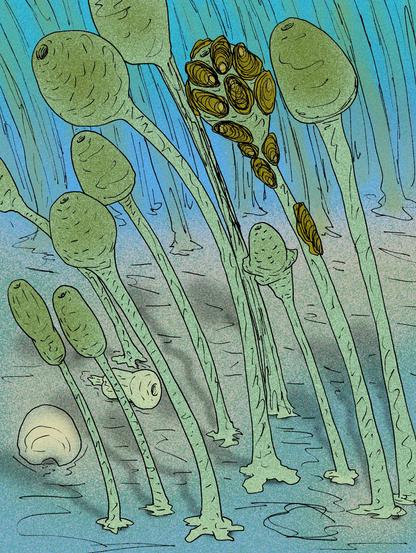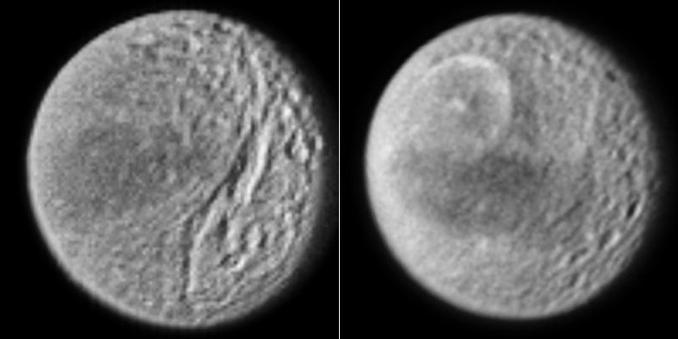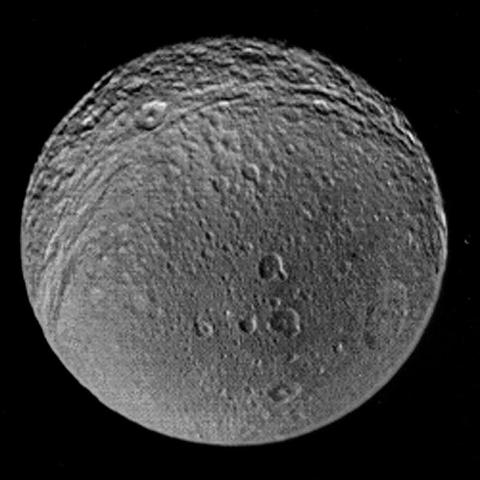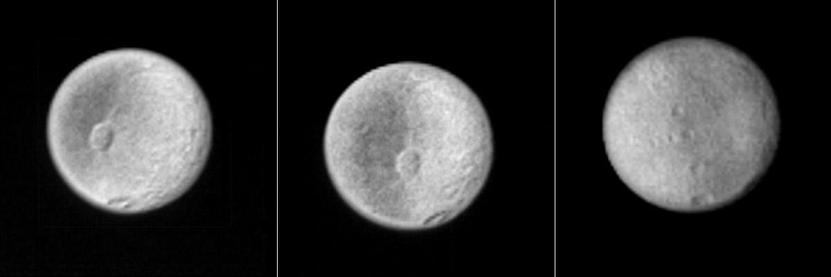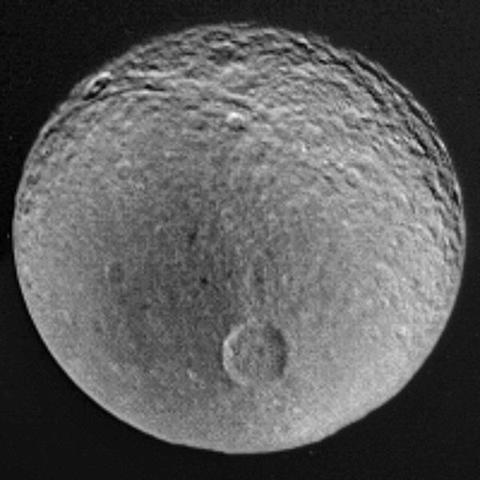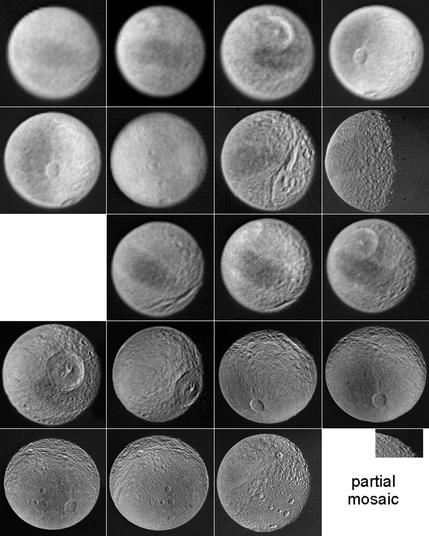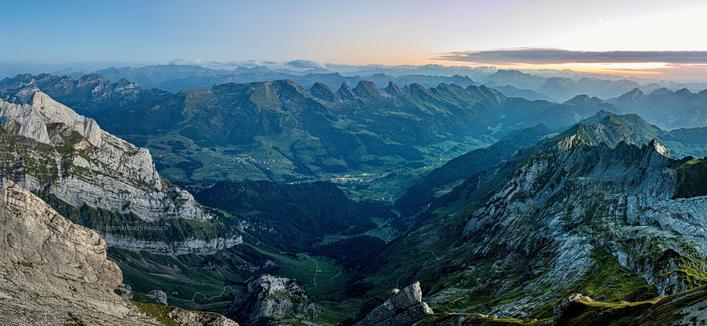Siphonia tulipa #sciart #siphonia #SPONGE #demospongiae #lithistida #hallirhoidae #cretaceous #tethys
#tethys
Wait… that’s no moon!!!
#StarWars #Saturn #Moon #Tethys
From: @setiinstitute
https://mastodon.social/@setiinstitute/113643805364068637
A last Tethys post - I decided to add one more. Since I didn't map Tethys, here is a Cassini photomosaic used as a key to names of craters etc. from the USGS Planetary Names website. It's a start but it could use some aesthetic enhancements. There is a reference at the bottom right corner to a paper about this work.
https://asc-planetarynames-data.s3.us-west-2.amazonaws.com/tethys_comp.pdf
Tomorrow, a new thread for some more Voyager images of other moons. I think we'll start with Enceladus as Voyager saw it. #Saturn #Voyager #Tethys
The second image of Tethys shows a white circle, seen in better images to be a large impact basin called Odysseus. It was identified immediately in Voyager images. But there is a second large circular basin seen only in the image at left, lying under and to the right of that large valley (Ithaca Chasma). That was not noticed at the time and was only identified in these specially processed images:
A bit more on Tethys as seen by the Voyager missions. Here are two images, Voyager 1 on the left, Voyager 2 on the right. The best Voyager images were of the other side of Tethys. The dark streak is curious - it extends around half of the equator. Explanations in the journals include impacts by E-ring particles, electrons in the magnetosphere and ejecta from the two co-orbital moons of Tethys.
A closer image from Voyager 2 shows something of what's happening. Here Penelope has the shading we expect from sunlight - bright on the right, dark on the left. But it's subdued. The dark coating nearly balances the brighter sunlight. In the lower resolution image from Voyager 1 the two effects (albedo and illumination) cancel each other out and Penelope disappears. The dark material acts like it is sprayed on. Other topography shows the same effect. #Saturn #Voyager #Tethys
What's up with Penelope? Here are three images from Voyager 1, watching Tethys rotate. Penelope is in the left and middle images but where is it in the right image? And the shading on the crater wall - in the middle there should be no shading, the Sun's overhead.
Whatever that dark stuff is to the west (left) of Penelope, some of it has darkened the eastern (right) wall of the crater. The opposite wall of the crater was not darkened, as if sheltered from the dark material. #Voyager #Tethys
Here is a Voyager 2 image of Penelope, a prominent crater on Tethys. The processing here exaggerates albedo variations. If you were there it would look much less contrasty. The big crater is Penelope, and it looks pretty much as you would expect a crater to look, and like all the smaller craters seen best around the top of the disk. Sunlight makes one wall bright, the other is shaded. But that's wrong - look where it is. The Sun should be overhead. #Saturn #Voyager #Tethys
A few quick observations. We see dark markings in two areas, one running part way round the equator (top and middle rows), the other opposite it and more extended north-south. The second one is redder than the first (not visible in my B/W versions). Note the prominent crater Penelope in the top right image, the first in the 2nd row, and in images in the bottom 2 rows. There's something very peculiar about Penelope - as we will see tomorrow. #Saturn #Voyager #Tethys
On to Saturn's moons now. My intention was to get the most out of Voyager images before Cassini arrived. The best Voyager images are often seen but there are others with very interesting stories to tell. We'll start with Tethys. This image is a sort of index to the full imaging dataset for Tethys. Each image has been treated as I did for Ariel and Umbriel - the shading gradient caused by its spherical shape is suppressed and local features are enhanced. #Saturn #Voyager #Tethys
Kann man Verfinsterungen der Saturnmonde im Teleskop beobachten?
I get that everyone now wants to discover a new #carbon cycle perturbation in the geological record... but I have to say, this one is a bit weak.
Those are nice records, don't get me wrong, and more meat on the early #Triassic is always nice, but it doesn't feel enough to call it "Tethys-wide" (for a given value of #Tethys).
https://www.sciencedirect.com/science/article/pii/S0031018224004620
Minor #paleogeographic rant.
Papers from last night are now jumbled in my brain and annoying me as some European researchers can't seem to make the distinction between the #Tethys #Ocean and the Mesozoic #InlandSeas across western Europe, so they also call them the Tethys. It's confusing and leads to some weird lines like "desiccation of the Tethys." (The names of the offenders will not be mentioned to protect them, and also, I don't want to go over all those papers again to find it)
Saturnian moons Titan and Tethys in clear view as the shadow of Saturn darkens the far arm of the rings.
#Cassini Imaging Team
Hier war mal Meer, die #Tethys. Man könnte auch sagen, in der #Schweiz stehen wir eigentlich auf afrikanischem Boden. 😳 Habe ich neulich von einem renommierten Geologen gelernt (Christian Klepp).
Foto: Blick vom #Säntis zu den #Churfirsten.
#Fotografie #Landschaft #Berge #Ostschweiz #Schweiz #Appenzell #Fotoideen #MeerMittwoch #Geologie #Alpen
Mantle Convection Linked To Seaway Closure That Transformed Earth's Oceanographic Circulation Patterns
--
https://phys.org/news/2024-03-mantle-convection-linked-seaway-closure.html <-- shared technical article
--
https://doi.org/10.1016/j.epsl.2024.118615 <-- shared paper
--
#GIS #spatial #mapping #model #modeling #paleogeography #paleoclimatology #tethys #geology #structuralgeology #ContinentalDrift #platetectonics #oceancirculation #climate #Paleogene #Cenozoic #arctic #neotethys #WestSiberianSeaway #bathymetry #paleobathymetry #mantle #plates #topography #paleoenvironment #DEMs #geophysics #seismology #Eocene #convection #seaway #oceangraphy #circulation #marine
Heute (21.03.2024) vor...
...340 Jahren Saturnmonde #Tethys und #Dione entdeckt
Mehr https://astronomiemuseum.de/heute-vor
#Astronomiemuseum
Tethys (moře) (Paleogeografie 🦕)
Tethys bylo prehistorické moře rovnoběžkového směru. Vzniklo v druhohorách v Triasu, zhruba před 250 miliony let. Kontinent Pangea se zhruba ve svém středu rozdělil na severní a jižní část. Mezi nimi vzniklo moře Tethys, které sahalo od nynějšího Mexického zálivu přes Španělsko, Itálii, pohoří Himálaj až na Malajský poloostrov. Představo...
https://cs.wikipedia.org/wiki/Tethys_(moře)
#Tethys #More #Mezozoikum #Fanerozoikum #Paleogeografie #VyvojZemskehoPovrchu
